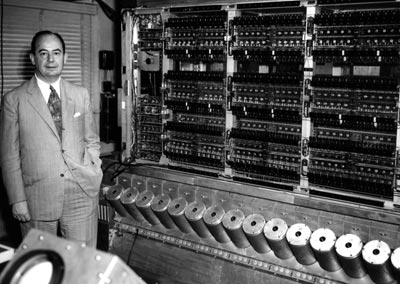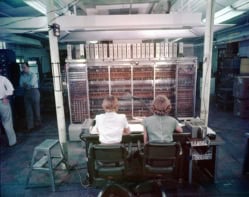Turing's Cathedral: the Origins of the Digital Universe
George Dyson
2012 Pantheon Books £25.00/$29.95 hb 423pp

George Dyson has written a fascinating but flawed history of the computer. The son of the distinguished physicist Freeman Dyson, he was born in 1953 and as a child was witness to the world of computing unfolding at the Institute for Advanced Study (IAS) in Princeton, New Jersey, where his father was a professor. In Turing’s Cathedral: the Origins of the Digital Universe, he revisits the scene of his childhood in order to set local events in the context of global computer development. The impression is of a child not quite making sense of the grown-up world (rather like the children in To Kill a Mockingbird).
The most glaring flaw in the book is that Dyson claims that the IAS computer was the first practical computer that ushered in the dawn of the computer age. Fact: the first practical computer was the EDSAC, completed at the University of Cambridge in May 1949; the IAS computer first worked some 18 months later, and several other computers came on stream between these dates. This error is a great shame because there is in this book an important story that deserves to be told – and Dyson has told it well – but the book’s credibility is undermined by this petty claim about the priority of the IAS computer over other machines, and a sprinkling of other historical infelicities. Otherwise, the book is meticulously researched: Dyson has made extensive use of the Princeton University archives, visited numerous other archives, and interviewed several of the participants – now mostly in their 80s. He has also raided the Princeton archives for a superb set of photographs.
The central figure in the book is John von Neumann. During the Second World War, Von Neumann was a consultant to the Manhattan Project at Los Alamos, and was heavily involved in the intensive mathematical calculations needed to design the atomic bomb. In 1944 this need for calculating power led him to the ENIAC, a clumsy electronic behemoth built by the University of Pennsylvania for the US Army’s Ballistics Research Laboratory. Von Neumann collaborated with the designers of the ENIAC to produce a more effective design, which we now know as the stored-program computer – the blueprint for the post-war computer revolution.
Prior to his involvement with the ENIAC team, Von Neumann had become aware of Alan Turing’s theoretical work on computing, which Turing had carried out in 1936 at Cambridge before becoming a research student at Princeton University. Von Neumann was the only member of the ENIAC group who was aware of Turing’s work and the degree to which it influenced the stored-program computer is uncertain. Dyson has no such uncertainties, hence the title of the book.
After the war Von Neumann established a project to build a computer at the IAS. The IAS, the epicentre of theoretical science, was decidedly sniffy about hosting a bunch of engineers and their machinery. But the development was allowed to go ahead, tucked out of sight in the basement of the mathematics department, next to the men’s toilets. Dyson gives an excellent account of the academic politics and the engineering heroics that brought the computer into existence.
Although the IAS computer was not the first, it was probably the most influential computer design of its era. Moreover, at least as important as the computer itself were the seminal reports produced by Von Neumann and his colleague Herman Goldstine between 1946 and 1948 that were eagerly devoured around the world. The IAS computer (which Dyson incorrectly calls the MANIAC; in fact it was never named) had numerous clones, including the (real) MANIAC at Los Alamos, the JOHNNIAC at the RAND Corporation, ORACLE at Oak Ridge, SILLIAC at the University of Sydney, the WEIZAC in Israel and a dozen more. Further, Von Neumann was a consultant to IBM, which based its first mainframe computers on the IAS design. But this was a time of simultaneous invention, and had the IAS computer not been built we would be in much the same place today.
In the post-war period, Von Neumann earned a reputation as one of the most hawkish of scientists, becoming a member of the Atomic Energy Commission and an advocate for the H-bomb. The MANIAC computer was built primarily for nuclear-weapons calculations, and it was at Los Alamos that Von Neumann and Stanislaw Ulam invented the famed Monte Carlo method. When conventional computer methods were too slow or intractable, the Monte Carlo method could be used to evaluate a system at random points. The result was a kind of scatter diagram that approximated the result – the more points evaluated, the greater the precision. The Monte Carlo method was soon applied across the sciences. Von Neumann went on to apply similar techniques to numerical weather prediction, presaging today’s massive use of high-performance computers for meteorological forecasting.
Dyson’s odyssey into the origins of computing takes in Von Neumann’s last brilliant foray into the theory of self-reproducing automata. Like Turing, Von Neumann was fascinated by the computer’s potential for autonomous behaviour. Whereas Turing speculated on the ability of a computer to think, Von Neumann pondered on the power of machines to reproduce themselves. He devised minimal (and entirely theoretical) cellular automata that could asexually reproduce themselves. As it happened, neither of them outlived the 1950s. Turing, as is well known, committed suicide in 1954. Von Neumann died of cancer in 1956; he was a witness to the 1946 Bikini nuclear tests, and the cancer may not have been unconnected. Both Turing’s and Von Neumann’s speculations of the 1950s remain distant but not-forgotten prospects.



